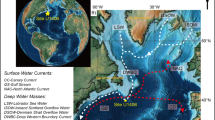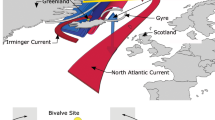Abstract
The tropics have been suggested as the drivers of global ocean and atmosphere circulation and biogeochemical cycling during the extreme warmth of the Cretaceous period1,2; but the links between orbital forcing, freshwater runoff and the biogeochemistry of continental margins in extreme greenhouse conditions are not fully understood. Here we present Cretaceous records of geochemical tracers for freshwater runoff obtained from a sediment core off the Ivory Coast that indicate that alternating periods of arid and humid African climate were driven by orbital precession. Our simulations of the precession-driven patterns of river discharge with a global climate model suggest that ocean anoxia and black shale sedimentation were directly caused by high river discharge, and occurred specifically when the northern equinox coincided with perihelion (the minimum distance between the Sun and the Earth). We conclude that, in a warm climate, the oceans off tropical continental margins respond rapidly and sensitively to even modest changes in river discharge.
This is a preview of subscription content, access via your institution
Access options
Subscribe to this journal
Receive 51 print issues and online access
$199.00 per year
only $3.90 per issue
Buy this article
- Purchase on Springer Link
- Instant access to full article PDF
Prices may be subject to local taxes which are calculated during checkout



Similar content being viewed by others
References
Wilson, P. A. & Norris, R. D. Warm tropical ocean surface and global anoxia during the mid-Cretaceous period. Nature 412, 425–429 (2001)
Norris, R. D., Bice, K. L., Magno, E. A. & Wilson, P. A. Jiggling the tropical thermostat in the Cretaceous hothouse. Geology 30, 299–302 (2002)
Dean, W. E., Arthur, M. A. & Stow, D. A. V. Origin and geochemistry of Cretaceous black shales and multicoloured claystones, with emphasis on Deep Sea Drilling Project Site 530, southern Angola Basin. DSDP Init. Rep. 75, 819–844 (1984)
Erlich, R. N., Palmer-Koleman, S. E. & Antonieta Lorente, M. Geochemical characterization of oceanographic and climatic changes recorded in upper Albian to lower Maastrichtian strata, western Venezuela. Cretac. Res. 20, 547–581 (1999)
Rusk, D. C. in Petroleum Provinces of the Twenty-first Century (eds Downey, M. W., Threet, J. C. & Morgan, W. A.) 429–452 (Memoir 74, AAPG, Tulsa, 2001)
Hofmann, P., Wagner, T. & Beckmann, B. Millennial- to centennial-scale record of African climate variability and organic carbon accumulation in the Coniacian-Santonian eastern tropical Atlantic (Ocean Drilling Program Site 959, off Ivory Coast and Ghana). Geology 31, 135–138 (2003)
Beckmann, B., Wagner, T. & Hofmann, P. in The Deposition of Organic-Carbon-Rich Sediments: Models, Mechanisms, and Consequences (ed. Harris, N. B.) 125–143 (Spec. Publ. 82, SEPM, Washington, 2005)
Wagner, T., Sinninghe Damsté, J. S., Hofmann, P. & Beckmann, B. Euxinia and primary production in Late Cretaceous eastern equatorial Atlantic surface waters fostered orbitally driven formation of marine black shales. Paleoceanography 19, doi:10.1029/2003PA000898 (2004)
Calvert, S. E. in Treatise on Chemical Oceanography 6 (eds Riley, J. P. & Chester, R.) 187–280 (Academic, San Diego, 1976)
Zabel, M. et al. Late Quaternary climate changes in Central Africa as inferred from terrigenous input to the Niger Fan. Quat. Res. 56, 207–217 (2001)
Diester-Haass, L. & Chamley, R. C. Palaeoceanographic and palaeoclimatic evolution in the Wedell Sea (Antarctica) during the middle Eocene-late Oligocene, from a coarse sediment fraction and clay mineral data (OCP 689). Mar. Geol. 114, 233–250 (1993)
Yarincik, K. M., Murray, R. W. & Peterson, L. C. Climatically sensitive eolian and hemipelagic deposition in the Cariaco Basin, Venezuela, over the past 578,000 years: Results from Al/Ti and K/Al. Paleoceanography 15, 210–228 (2000)
DeConto, R. M., Hay, W. W., Thompson, S. L. & Bergengren, J. in The Evolution of the Cretaceous Ocean-Climate System (eds Barrera, E. & Johnson, C.) 391–406 (Spec. Pap. 332, Geol. Soc. Am., Boulder, 1999)
Holbourn, A. E. L. et al. in The Oil and Gas Habitats of the South Atlantic (eds Cameron, N. R., Bate, R. H. & Clure, V. S.) 195–222 (Spec. Publ. 153, Geol. Soc., London, 1999)
Wagner, T. Late Cretaceous to early Quaternary organic sedimentation in the eastern equatorial Atlantic. Palaeogeogr. Palaeoclimatol. Palaeoecol. 179, 113–147 (2002)
Rey, O., Simo, J. A. & Lorente, M. A. A record of long- and short-term environmental and climatic change during OAE3: La Luna Formation, Late Cretaceous (Santonian-early Campanian), Venezuela. Sedim, Geol. 170, 85–105 (2004)
Thompson, S. L. & Pollard, D. A global climate model (GENESIS) with a land-surface-transfer scheme (LSX). Part 1: Present-day climate. J. Clim. 8, 732–761 (1995)
Bice, K. L., Barron, E. J. & Peterson, W. H. Continental runoff and early Cenozoic bottom-water sources. Geology 25, 951–954 (1997)
Alychunskaya, N. M. & Ivanov, V. V. in World Water Balance and Water Resources of the Earth (ed. Korzun, V. I.) 568–574 (Studies and Reports in Hydrology 25, UNESCO, Paris, 1978)
Hay, W. W., et al. in The Evolution of the Cretaceous Ocean-climate System (eds Barrera, E. & Johnson, C.) 1–48 (Spec. Pap. 332, Geol. Soc. Am., Boulder, 1999)
Watkins, D. K., Shafik, S. & Shin, I. C. Calcareous nannofossils from the Cretaceous of the Deep Ivorian Basin. ODP Sci. Res. 159, 319–333 (1998)
Kuhnt, W., Moullade, M. & Kaminski, M. A. Upper Cretaceous, K/T boundary, and Paleocene agglutinated foraminifers from Hole 959D (Côte d'Ivoire-Ghana Transform Margin). ODP Sci. Res. 159, 389–411 (2004)
Shipboard Scientific Party. Explanatory notes. Proc. ODP Init. Rep. 207, 1–94 (2004)
Acknowledgements
We thank the Ocean Drilling Program for providing the sample material and technical assistance. H. Heilmann, R. Henning, B. Kockisch, M. Gölden, S. Berg, A. Katzemich, S. Reiss, M. Aiyswaryan, R. Kunze and D. Pollard are thanked for analytical assistance.
Author information
Authors and Affiliations
Corresponding author
Ethics declarations
Competing interests
Reprints and permissions information is available at npg.nature.com/reprintsandpermissions. The authors declare no competing financial interests.
Supplementary information
Supplementary Notes
This contains information on time-frequency analysis as well as specifications on experimental set-up of GENESIS 2.0. This file also contains Supplementary Figure S1. (DOC 543 kb)
Rights and permissions
About this article
Cite this article
Beckmann, B., Flögel, S., Hofmann, P. et al. Orbital forcing of Cretaceous river discharge in tropical Africa and ocean response. Nature 437, 241–244 (2005). https://doi.org/10.1038/nature03976
Received:
Accepted:
Issue Date:
DOI: https://doi.org/10.1038/nature03976
This article is cited by
-
Pre-Cenozoic cyclostratigraphy and palaeoclimate responses to astronomical forcing
Nature Reviews Earth & Environment (2024)
-
Water discharge variations control fluvial stratigraphic architecture in the Middle Eocene Escanilla formation, Spain
Scientific Reports (2023)
-
Organic geochemical and petrological evaluation to assess the remaining hydrocarbon potential and depositional conditions: a case study of the Paleozoic shales of west Perlis region, northern Peninsular Malaysia
Arabian Journal of Geosciences (2022)
-
Response of a continental fault basin to the global OAE1a during the Aptian: Hongmiaozi Basin, Northeast China
Scientific Reports (2021)
-
Multifractal characterization of the Coniacian–Santonian OAE3 in lacustrine and marine deposits based on spectral gamma ray logs
Scientific Reports (2020)
Comments
By submitting a comment you agree to abide by our Terms and Community Guidelines. If you find something abusive or that does not comply with our terms or guidelines please flag it as inappropriate.



